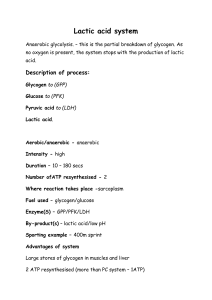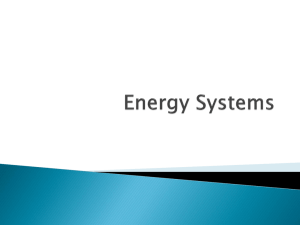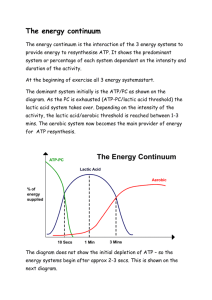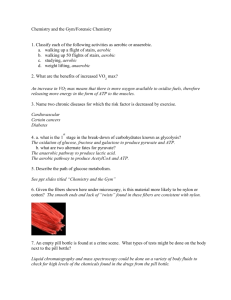Intro to Exercise Physiology & Energy Systems
advertisement
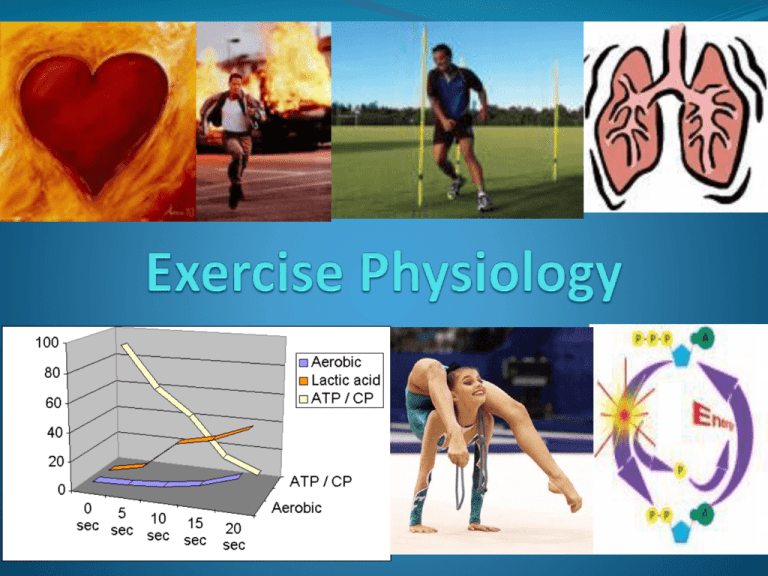
Exercise Physiology Studies a range of SYSTEMS in the human body. These systems allow us to perform the various activities we do, and more importantly. enable us to live. Exercise Physiology requires us to understand the following information: • Muscular Systems – how they contract & relax and their • • • • microscopic structures. Energy Systems – how we get energy to move. Circulatory Systems – the heart & blood. Respiratory System – the lungs Nervous Systems – the brain & how it controls movement & processes In this unit we will learn about Energy systems – and how we get energy to move. How our body responds to exercise. The heart and lungs. The Energy Systems 1) 2) 1. 2. 3. Energy for muscle contractions can be supplied in two ways: Either Anaerobically – without oxygen, or Aerobically – with oxygen. In the body there are three main pathways for the breakdown of ATP to make energy. These systems are dependent on the type of activity being performed. The Three Pathways Are: ATP-CP Anaerobic – (lactic acid) Aerobic The ATP-PC System This energy system provides energy for the activities of short duration and high intensity hence it does not require oxygen. The ATP-PC system will only last up to 10 seconds when there is not any recovery time because the ATP & PC becomes exhausted. The ATP-PC system is used during 100m sprints, shot put, high- jump and other activities that are completed in only a few seconds. The Lactic Acid System The Lactic Acid system is also anaerobic (ie. No Oxygen). It is the system that ‘kicks-in’ when the ATPPC system can no longer produce energy. The lactic acid system provides energy for up to 3 minutes hence it is used for activities such as 400m & 800m running events or middle distance swimming. The main source of fuel for this system is Carbohydrates. One problem with the Lactic Acid system is that a byproduct called Lactic Acid builds up in the muscles and blood. It is this by-product produced during intense exercise that causes fatigue. The Aerobic System The aerobic system produces ATP in the presence of oxygen. It is this system that is used during rest & everyday activities such as mowing the lawns, walking etc. During intense exercise it is the aerobic system that ‘kicks-in’ after 2-3 minutes. The aerobic system produces far more ATP than any other system because it is produced when oxygen is present. Not only this, oxygen being present also prevents the build-up of Lactic Acid. The Three Energy Systems 100 % Energy Contribution Red – Green – Pale Blue - 50 0 0 10 20 30 40 50 60 120 180 Running Time (seconds) 240 300 360 Task – Identify the energy system at work. Activity Golf Swing Javelin Marathon 200m Swim Volleyball Spike 1500m Run Walking 30 sec Burst Power-lifting Beep Test ATP-CP Lactic Acid Aerobic Task - Answers Activity ATP-CP Golf Swing X Javelin X Lactic Acid Marathon X 200m Swim Volleyball Spike X X 1500m Run X Walking X 30 sec Burst X Power-lifting X Beep Test Aerobic X Using your notes on energy systems, complete the following table: Description ATP – CP (immediate) Lactic Acid (short term) Aerobic (long term) Source of Energy Time (predominately used) Classification Example Answers Description Source of Energy Time Classification Example (predominately used) ATP – PC (immediate) Used in high intensity, extremely short activities. ATP stored in the muscle cells. 0-10 sec Anaerobic (Does not require O2, and so does not cause a build up of lactic acid). Sprint starts, weight lifting, shot put… Lactic Acid (short term) Used in short term, high intensity exercise. Carbohydrates (glycogen) 30 sec – 2 mins Anaerobic (Does not require O2, but used carbos only, large amounts of lactic acid build up-hence decreased performance). 200m sprint, sit ups/ press ups… Aerobic (long term) Light – moderate intensive exercise. (The body can work for extended time without experiencing fatigue). Carbohydrates and fats. 2-3mins + (These intensive may vary from very easy to very hard) Aerobic (Because this system requires oxygen to burn carbos and fats, lactic acid does not build up-hence no effect on performance). Marathon runner or swimmer… Summary of Energy Systems ATP-PC System Lactic Acid System Aerobic System Anaerobic Anaerobic Aerobic Very rapid Rapid Slow Chemical: CP Food: glycogen Food: CHO, Fat, Protein Very limited ATP Limited ATP Unlimited ATP Muscular stores limited Lactic Acid causes fatigue No fatiguing by-products Explosive, sprint 30 sec to 3 min Endurance 100m 400m Marathon


